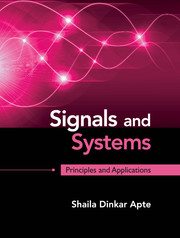Book contents
- Frontmatter
- Dedication
- Contents
- Preface
- 1 Introduction to Signals
- 2 Signals and Operations on Signals
- 3 CT and DT Systems
- 4 Time Domain Response of CT and DT LTI Systems
- 5 Fourier Series Representation of Periodic Signals
- 6 Fourier Transform Representation of Aperiodic Signals
- 7 Laplace Transform
- 8 Z Transform
- 9 Random Signals and Processes
- Index
5 - Fourier Series Representation of Periodic Signals
Published online by Cambridge University Press: 05 May 2016
- Frontmatter
- Dedication
- Contents
- Preface
- 1 Introduction to Signals
- 2 Signals and Operations on Signals
- 3 CT and DT Systems
- 4 Time Domain Response of CT and DT LTI Systems
- 5 Fourier Series Representation of Periodic Signals
- 6 Fourier Transform Representation of Aperiodic Signals
- 7 Laplace Transform
- 8 Z Transform
- 9 Random Signals and Processes
- Index
Summary
This chapter deals with the Fourier series representation of periodic CT signals. Chapter 4 dealt with the representation of signals in terms of impulses where the impulse function is treated as a basic unit. Any signal can be represented as a linear combination of scaled and shifted impulses. This chapter uses the decomposition of a signal in terms of sines and cosines or exponential signals and represents the signal as a vector with each coefficient of the vector representing the amount of similarity of the signal with the basic functions namely sines and cosines or exponential functions. This representation is termed as Fourier series representation after the scientist named Fourier who claimed that every signal can be represented as a linear combination of sinusoidal functions.
Firstly, we will study the representation of signals in terms of vectors, which makes it easy to understand the concept of orthogonality. The use of exponential series representation is elaborated. The trigonometric series representation and exponential representations are compared. We will then classify the signals as periodic and aperiodic. Periodic signals will be represented in terms of Fourier series representation. Aperiodic signals will be represented in terms of Fourier transform representation. Fourier series representation will be illustrated for CT and DT signals.
Signal Representation in Terms as Sinusoids
We have discussed the decomposition of any CT signal in terms of impulses and decomposition of any DT signal in terms of unit impulse function in chapter 4. Unit impulse is considered as a basic unit because the LTI systems can be characterized by impulse response. We can also decompose any signal in terms of sinusoids or in terms of complex exponentials. Here, the sinusoids or exponential functions are used as basic units. The decomposition of a signal as a linear combination of scaled sinusoids or complex exponentials is discussed further.
Why we select a sinusoid or complex exponentials?
The reason is when a sinusoid or complex exponential is given as input to any LTI system, the output is the same sinusoid or the same complex exponential except the change in amplitude and/or the change of phase. No other signal can have this claim. We will first prove that the sinusoids of different frequencies are orthogonal to each other and complex exponentials of different frequencies are also orthogonal to each other.
- Type
- Chapter
- Information
- Signals and SystemsPrinciples and Applications, pp. 331 - 408Publisher: Cambridge University PressPrint publication year: 2016



